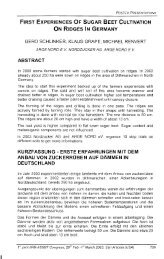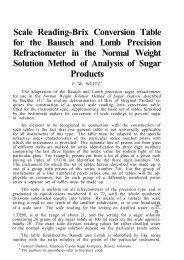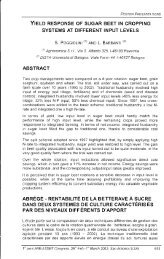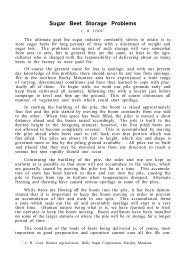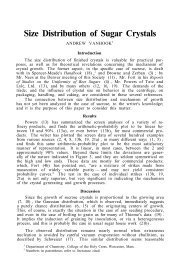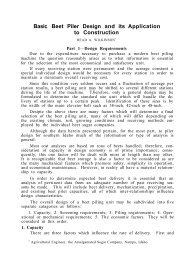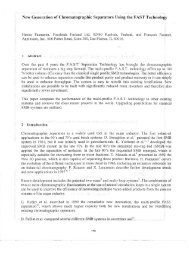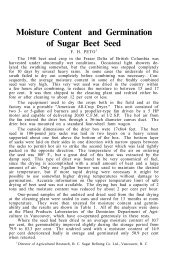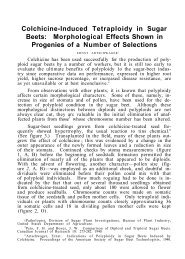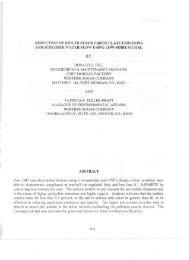Plant-Food Elements in Sugar Beets Throughout the Growing Season
Plant-Food Elements in Sugar Beets Throughout the Growing Season
Plant-Food Elements in Sugar Beets Throughout the Growing Season
Create successful ePaper yourself
Turn your PDF publications into a flip-book with our unique Google optimized e-Paper software.
100 AMERICAN- SOCIETY SUGAR-BEET TECHNOLOGISTS<br />
Rapid analyses tests, just prior to seed<strong>in</strong>g <strong>the</strong>se fields, verified<br />
<strong>the</strong> above relationship, so 200 pounds per acre of 2-12-10 were applied<br />
with <strong>the</strong> seed to <strong>the</strong> Clyde elay and 200 pounds per acre of<br />
2-16-6 to <strong>the</strong> Thames clay loam. Phosphate applications have consistently<br />
been found to be important <strong>in</strong> <strong>the</strong>se soils for <strong>in</strong>creas<strong>in</strong>g<br />
yields, though moisture and organic matter are undoubtedly limit<strong>in</strong>g<br />
factors.<br />
Conclusions<br />
The limited scope of this <strong>in</strong>vestigation doubtless leaves many<br />
gaps <strong>in</strong> <strong>the</strong> picture of <strong>the</strong> plant-food <strong>in</strong>take of sugar beets. More frequent<br />
and wider sampl<strong>in</strong>g would give smoo<strong>the</strong>r graphs and closer<br />
correlation <strong>in</strong> growth stages. The analyses of <strong>the</strong> f<strong>in</strong>al stage fit <strong>in</strong><br />
well with data published by <strong>the</strong> U. S. D. A. <strong>in</strong> 1941 on <strong>the</strong> ''M<strong>in</strong>eral<br />
Composition of Crops" (3).<br />
This experiment is of <strong>in</strong>terest <strong>in</strong> <strong>the</strong> picture it gives of <strong>the</strong> sugarbeet<br />
plant at various stages of growth, and po<strong>in</strong>ts to <strong>the</strong> need of adequate<br />
plant-food elements be<strong>in</strong>g available throughout <strong>the</strong> grow<strong>in</strong>g<br />
season.<br />
The question of a plant tak<strong>in</strong>g up elements <strong>in</strong> excess of growth<br />
requirements has not been discussed, but under field conditions,<br />
where yields seldom go above 15 tons per acre, it is probably not a<br />
factor.<br />
There is a differential call for plant-food elements <strong>in</strong> <strong>the</strong> roots<br />
and tops which changes considerably as <strong>the</strong> grow<strong>in</strong>g season progresses.<br />
The sugar-beet plant requires a plentiful supply of nitrogen and<br />
potash at all stages of growth, but <strong>the</strong> presence of phosphate, calcium,<br />
and magnesium <strong>in</strong> both roots and tops is evidence of <strong>the</strong>ir essential<br />
part <strong>in</strong> normal development.<br />
The data <strong>in</strong>dicate a need for correlation of <strong>in</strong>formation on soil<br />
contents with carefully planned fertilizer treatments.<br />
Literature Cited<br />
1. Willcox, O. W.—The Logistic Curve of <strong>Plant</strong> Growth, Pr<strong>in</strong>ciples<br />
of Agrobiology—page 48.<br />
2. Brown, H. D.—Apply<strong>in</strong>g Fertilizer to <strong>Sugar</strong> <strong>Beets</strong> <strong>in</strong> Ontario,<br />
Proceed<strong>in</strong>gs A. S. S. B. T. 1940—page 73.<br />
3. Beeson, K. C.—The M<strong>in</strong>eral Composition of Crops, U. S. D. A.<br />
Miscellaneous Publication No. 369, March 1941.



